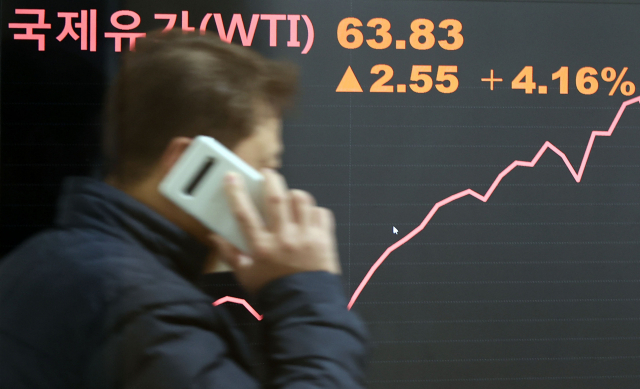Tightening inflation pressure
63.83弗 per WTI barrel… 4.2%↑
In the prospect of “2% US Treasury Bond Rate”
The won-dollar exchange rate was once around 1,130 won
“If the interest rate rises further, stocks will escape”
 viewer
viewer
Inflation pressures are getting stronger as the US Treasury bond rates surge and the prices of various commodities such as international oil prices rise. The US Federal Reserve (Fed, Fed) and the Bank of Korea say that supply-side inflation is a temporary phenomenon and prices are still low, but the market is wary of a sudden tightening that leads to inflation.
On the 5th, the 10-year Treasury Bond yield exceeded 2% during the week due to the rise in US Treasury yields and China’s gradual exit strategy, raising concerns about inflation. In particular, the increase in consumer prices in February last day rose to 1.1%, and oil prices reached their highest level in one year and ten months, and the market took a step closer to inflation. Of course, Fed Chairman Jerome Powell explained on the previous day that he would “be patient with inflation,” but the mayor interpreted it as a temporary patience.
 viewer
viewer
The target of patience is the increase in the base rate. As in the past, it means that it will not follow the procedure of’inflation concerns → market interest rate rise → base rate increase’. In particular, regarding the bond market, he stressed that “we are concerned about the disorder or the financial market situation that threatens our achievement of our goals.” Chairman Powell also emphasized that it is difficult to achieve an unemployment rate of 4%, and drew a line once again, saying that an average of 2% inflation is difficult this year. However, Powell’s remarks to appease the bond market increased the market’s anxiety. On the flip side, it has been interpreted as meaning that if the policy goal is achieved, interest rates will increase and tighten. Wall Street analyzed that the Fed sees the guarantee period of easing monetary policy at around one year.
The market expects supply and demand inflation to occur at the same time. In the US, retail sales in January this year surged 5.3% from the previous month, far exceeding market expectations. Demand is increasing rapidly as economic activity resumes, but the prediction that inflation will rise as supply cannot keep up is dominant. In addition, additional economic stimulus measures worth $1.9 trillion (about 2,143 trillion won) are pending.
The same goes for us. The inflation rate of agricultural and fishery products reached the highest level in 10 years, and retail sales (consumption) in January increased 1.6% from the previous month, increasing for two consecutive months.
The price of raw materials, which is the axis of supply, is on the rise amid signs of economic recovery supported by demand. On the same day, OPEC+ (the coalition of 10 oil producing countries including OPEC and Russia) decided to slightly increase crude oil production next month to a level close to freezing, and the April product of the New York Commercial Exchange West Texas crude (WTI) rose 2.55 dollars (4.2%) per barrel to 63.83. Finished the market on dollars. This is the highest level in about two years since April 2019. ING predicted that the bond market is above the gunpowder (due to inflation concerns) and that the 10-year Treasury bond rate could rise to 2% within the year. On Wall Street, it is predicted that the Fed will not be able to alleviate market unrest without a’operation twist’ in which it sells short-term bonds and buys more long-term bonds.
The expansion of volatility in the financial market arising from inflation concerns is also directly affecting the won-dollar exchange rate. Due to disappointment with Chairman Powell’s remarks, it started at 1,132 won, up 6 won 90 times compared to the previous trading day. The won-dollar exchange rate has entered the 1,130 won range in four months since November 4 last year (70 before the closing price of 1,137 won). After regaining stability, the won-dollar exchange rate increased by 1 won compared to the previous trading day by 1,126 won, and the transaction ended 10 before. A researcher at Daeshin Securities Co-Rack pointed out that the reason why the won-dollar exchange rate exceeded 1,130 won and stabilized was due to the expectation that the Fed will not see an interest rate rise.
What is of concern is the case where the inflation rate continues to surge while liquidity is being loosened. Seoul National University’s economics professor Kim So-young said, “There are concerns that capital outflows or stock market breakouts may occur if long-term interest rates rise further. If that happens, it may be affected not only by inflation but also by the recovering economy.
/ Reporter Jo Ji-won [email protected], Reporter Kim Young-pil [email protected]
< 저작권자 ⓒ 서울경제, 무단 전재 및 재배포 금지 >
